2010 HONDA FIT lock
[x] Cancel search: lockPage 19 of 351

ꭧ: If equipped
Vehicle with navigation system is shown.DRIVER'S FRONT AIRBAG
(P. 9, 25)
MIRROR CONTROLS
(P. 101)
DOOR LOCK TAB
(P. 81)
POWER DOOR LOCK
MASTER SWITCH
ꭧ
(P. 81)
POWER WINDOW SWITCHES
(P. 100)
HOOD RELEASE
HANDLE
(P. 200)
INSTRUMENT PANEL
INDICATOR (P. 60)
GAUGES (P. 68)
AUDIO SYSTEM
(P. 115, 143)
PASSENGER'S FRONT
AIRBAG
(P. 9, 25)
USB ADAPTER CABLE
ꭧ
(P. 130, 137, 171, 178)
HEATING/COOLING
CONTROLS
ꭧ
(P. 110)
PARKING BRAKE
(P. 102) AUTOMATIC TRANSMISSION (P. 219)
MANUAL TRANSMISSION (P. 217)NAVIGATION SYSTEM
ꭧ
CONTINUED
Your Vehicle at a Glance
3
Your Vehicle at a Glance
Page 21 of 351

This section gives you important
information about how to protect
yourself and your passengers. It shows
you how to use seat belts. It explains
how your airbags work. And it tells you
how to properly restrain infants and
children in your vehicle.
Important Safety Precautions.............
6
Your Vehicle's Safety Features ..........
7
Seat Belts .....................................
8
Airbags ........................................
9
Protecting Adults and Teens ...........
11
1. Close and Lock the Doors ........
11
2. Adjust the Front Seats .............
11
3. Adjust the Seat-Backs ..............
12
4. Adjust the Head Restraints ......
13
5. Fasten and Position the Seat Belts ..................................
14
6. Maintain a Proper Sitting Position ..............................
15
Advice for Pregnant Women ........
16
Additional Safety Precautions ......
17
Additional Information About Your
Seat Belts ............................... 18
Seat Belt System Components .....
18 Lap/Shoulder Belt
......................19
Automatic Seat Belt Tensioners .............................
20
Seat Belt Maintenance ................
20
Additional Information About Your
Airbags ..................................
22
Airbag System Components ........
22
How Your Front Airbags Work ....
25
How Your Side Airbags Work ......
28
How Your Side Curtain Airbags Work .....................................
30
How the SRS Indicator Works .....
30
How the Side Airbag Off
Indicator Works .....................
31
How the Passenger Airbag Off Indicator Works .....................
31
Airbag Service ............................
32
Additional Safety Precautions ......
33
Protecting Children -General
Guidelines ..............................
34
All Children Must Be Restrained ..............................
34
All Children Should Sit in a Back
Seat ....................................... 35
The Passenger's Front Airbag
Can Pose Serious Risks ...........
35If You Must Drive with Several
Children ................................
37
If a Child Requires Close Attention ................................
37
Additional Safety Precautions ......
38
Protecting Infants and Small Children .................................
39
Protecting Infants .......................
39
Protecting Small Children ...........
40
Selecting a Child Seat .....................
41
Installing a Child Seat .....................
42
Installing a Child Seat with LATCH ..................................
43
Installing a Child Seat with a
Lap/Shoulder Belt ..................
45
Installing a Child Seat with a Tether ...................................
47
Protecting Larger Children .............
49
Checking Seat Belt Fit ................
49
Using a Booster Seat ...................
50
When Can a Larger Child Sit in Front .....................................
51
Additional Safety Precautions ......
52
Carbon Monoxide Hazard ...............53
Safety Labels ..................................
54
Driver and Passenger Safety
5
Driver and Passenger Safety
Page 23 of 351
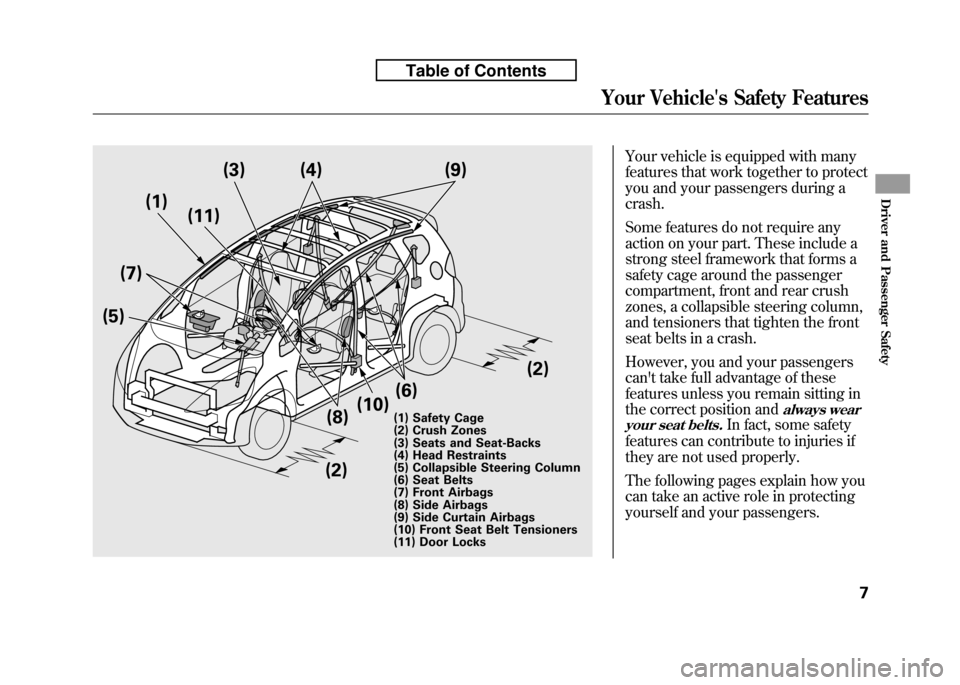
Your vehicle is equipped with many
features that work together to protect
you and your passengers during acrash.
Some features do not require any
action on your part. These include a
strong steel framework that forms a
safety cage around the passenger
compartment, front and rear crush
zones, a collapsible steering column,
and tensioners that tighten the front
seat belts in a crash.
However, you and your passengers
can't take full advantage of these
features unless you remain sitting in
the correct position and
always wear
your seat belts.
In fact, some safety
features can contribute to injuries if
they are not used properly.
The following pages explain how you
can take an active role in protecting
yourself and your passengers.
(7) (1)
(4)
(5) (9)
(3)
(11)
(2)(8)
(10) (6) (2)
(1) Safety Cage
(2) Crush Zones
(3) Seats and Seat-Backs
(4) Head Restraints
(5) Collapsible Steering Column
(6) Seat Belts
(7) Front Airbags
(8) Side Airbags
(9) Side Curtain Airbags
(10) Front Seat Belt Tensioners
(11) Door Locks
Your Vehicle's Safety Features
7
Driver and Passenger Safety
Table of Contents
Page 27 of 351
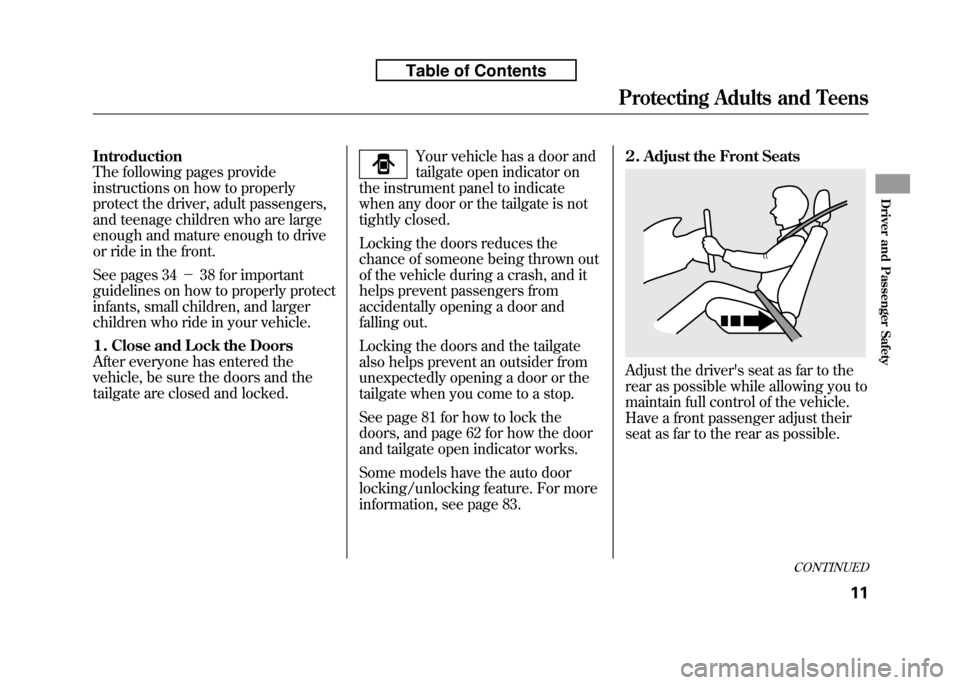
Introduction
The following pages provide
instructions on how to properly
protect the driver, adult passengers,
and teenage children who are large
enough and mature enough to drive
or ride in the front.
See pages 34-38 for important
guidelines on how to properly protect
infants, small children, and larger
children who ride in your vehicle.
1. Close and Lock the Doors
After everyone has entered the
vehicle, be sure the doors and the
tailgate are closed and locked.Your vehicle has a door and
tailgate open indicator on
the instrument panel to indicate
when any door or the tailgate is not
tightly closed.
Locking the doors reduces the
chance of someone being thrown out
of the vehicle during a crash, and it
helps prevent passengers from
accidentally opening a door and
falling out.
Locking the doors and the tailgate
also helps prevent an outsider from
unexpectedly opening a door or the
tailgate when you come to a stop.
See page 81 for how to lock the
doors, and page 62 for how the door
and tailgate open indicator works.
Some models have the auto door
locking/unlocking feature. For more
information, see page 83. 2. Adjust the Front Seats
Adjust the driver's seat as far to the
rear as possible while allowing you to
maintain full control of the vehicle.
Have a front passenger adjust their
seat as far to the rear as possible.
CONTINUED
Protecting Adults and Teens
11
Driver and Passenger Safety
Table of Contents
Page 28 of 351
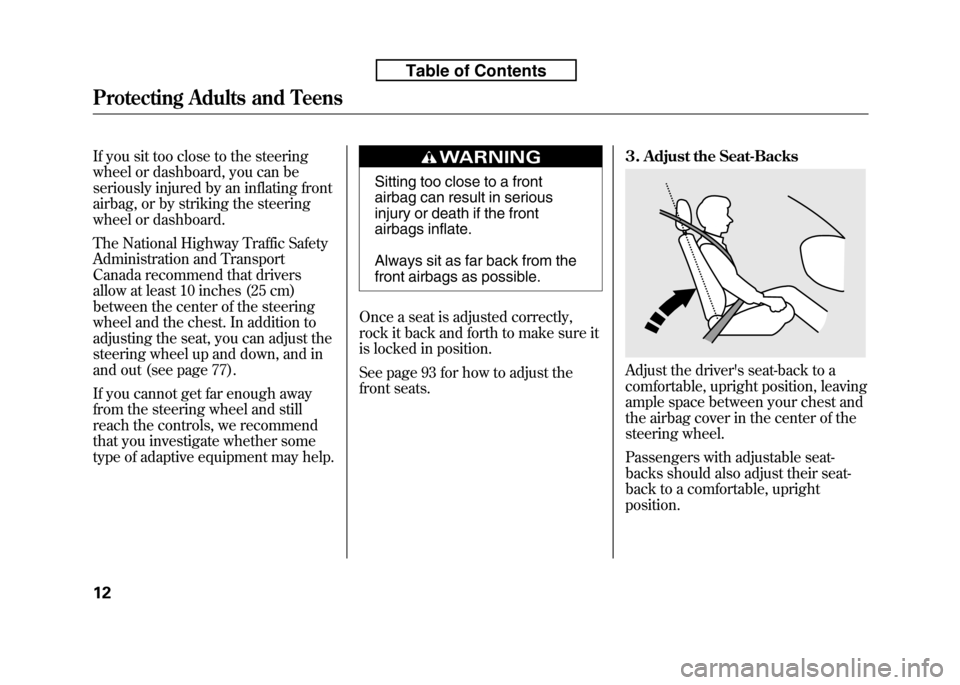
If you sit too close to the steering
wheel or dashboard, you can be
seriously injured by an inflating front
airbag, or by striking the steering
wheel or dashboard.
The National Highway Traffic Safety
Administration and Transport
Canada recommend that drivers
allow at least 10 inches (25 cm)
between the center of the steering
wheel and the chest. In addition to
adjusting the seat, you can adjust the
steering wheel up and down, and in
and out (see page 77).
If you cannot get far enough away
from the steering wheel and still
reach the controls, we recommend
that you investigate whether some
type of adaptive equipment may help.
Sitting too close to a front
airbag can result in serious
injury or death if the front
airbags inflate.
Always sit as far back from the
front airbags as possible.
Once a seat is adjusted correctly,
rock it back and forth to make sure it
is locked in position.
See page 93 for how to adjust the
front seats. 3. Adjust the Seat-Backs
Adjust the driver's seat-back to a
comfortable, upright position, leaving
ample space between your chest and
the airbag cover in the center of the
steering wheel.
Passengers with adjustable seat-
backs should also adjust their seat-
back to a comfortable, uprightposition.
Protecting Adults and Teens
12
Table of Contents
Page 35 of 351
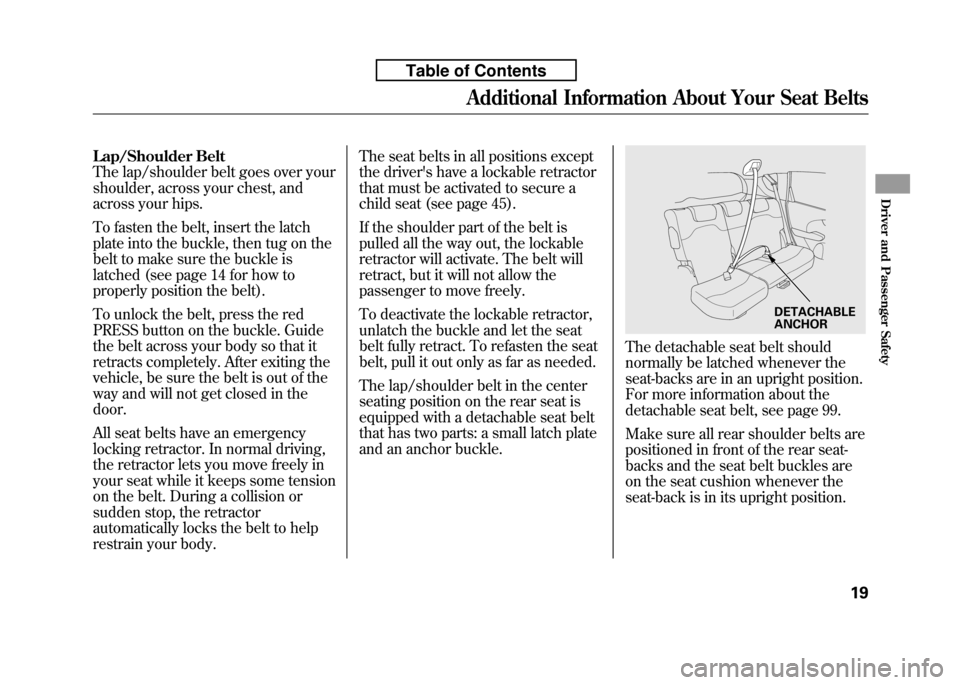
Lap/Shoulder Belt
The lap/shoulder belt goes over your
shoulder, across your chest, and
across your hips.
To fasten the belt, insert the latch
plate into the buckle, then tug on the
belt to make sure the buckle is
latched (see page 14 for how to
properly position the belt).
To unlock the belt, press the red
PRESS button on the buckle. Guide
the belt across your body so that it
retracts completely. After exiting the
vehicle, be sure the belt is out of the
way and will not get closed in thedoor.
All seat belts have an emergency
locking retractor. In normal driving,
the retractor lets you move freely in
your seat while it keeps some tension
on the belt. During a collision or
sudden stop, the retractor
automatically locks the belt to help
restrain your body.The seat belts in all positions except
the driver's have a lockable retractor
that must be activated to secure a
child seat (see page 45).
If the shoulder part of the belt is
pulled all the way out, the lockable
retractor will activate. The belt will
retract, but it will not allow the
passenger to move freely.
To deactivate the lockable retractor,
unlatch the buckle and let the seat
belt fully retract. To refasten the seat
belt, pull it out only as far as needed.
The lap/shoulder belt in the center
seating position on the rear seat is
equipped with a detachable seat belt
that has two parts: a small latch plate
and an anchor buckle.
The detachable seat belt should
normally be latched whenever the
seat-backs are in an upright position.
For more information about the
detachable seat belt, see page 99.
Make sure all rear shoulder belts are
positioned in front of the rear seat-
backs and the seat belt buckles are
on the seat cushion whenever the
seat-back is in its upright position.
DETACHABLE ANCHOR
Additional Information About Your Seat Belts
19
Driver and Passenger Safety
Table of Contents
Page 54 of 351

Additional Safety Precautions●
Never hold an infant or child on
your lap.
If you are not wearing a
seat belt in a crash, you could be
thrown forward and crush the
child against the dashboard or a
seat-back. If you are wearing a seat
belt, the child can be torn from
your arms and be seriously hurt orkilled.
●
Never put a seat belt over yourself and a child.
During a crash, the
belt could press deep into the child
and cause serious or fatal injuries.
●
Never let two children use the same seat belt.
If they do, they
could be very seriously injured in acrash. ●
Make sure any unused seat belt
that a child can reach is buckled,
the lockable retractor is activated,and the belt is fully retracted and
locked.
If a child wraps a loose
seat belt around their neck, they
can be seriously or fatally injured.
(See pages 45 and 46 for how to
activate and deactivate the
lockable retractor.)
●
Use the childproof door locks to prevent children from opening the
rear doors.
This can prevent
children from accidentally falling
out (see page 82).
●
Do not leave children alone in a vehicle.
Leaving children without
adult supervision is illegal in most
states, Canadian provinces and
territories, and can be veryhazardous. For example, infants and small
children left in a vehicle on a hot
day can die from heatstroke. A
child left alone with the key in the
ignition switch can accidentally set
the vehicle in motion, possibly
injuring themselves or others.
●
Lock all doors and the tailgate when your vehicle is not in use.
Children who play in vehicles can
accidentally get trapped inside.
Teach your children not to play in
or around vehicles.
●
Keep vehicle keys/remote transmitters out of the reach of
children.
Even very young
children learn how to unlock
vehicle doors, turn on the ignition
switch, and open the tailgate,
which can lead to accidental injury
or death.
Protecting Children -General Guidelines
38
Table of Contents
Page 55 of 351
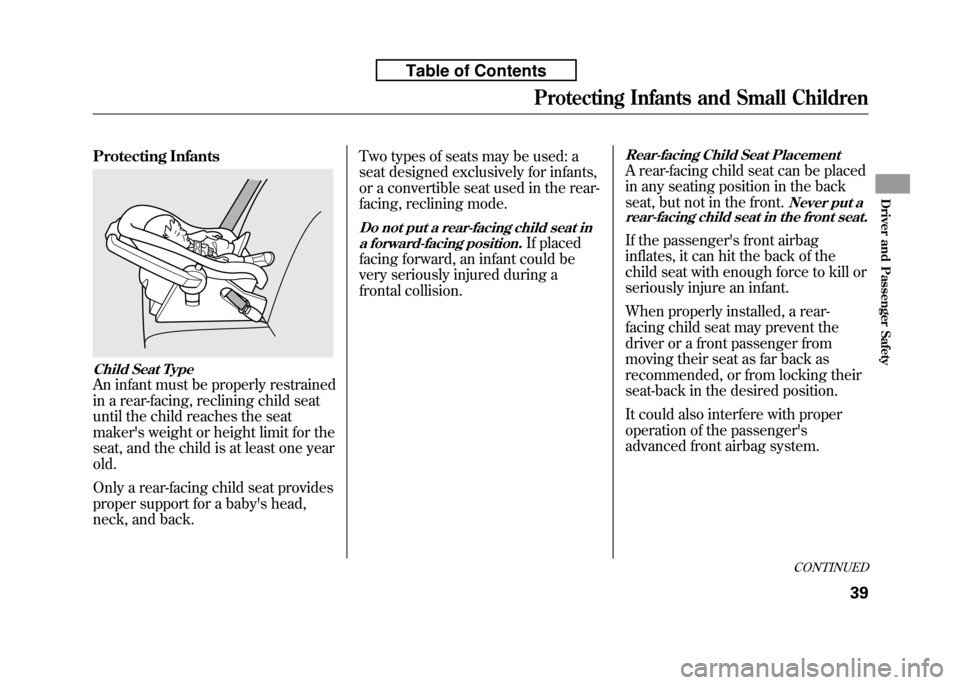
Protecting Infants
Child Seat Type
An infant must be properly restrained
in a rear-facing, reclining child seat
until the child reaches the seat
maker's weight or height limit for the
seat, and the child is at least one yearold.
Only a rear-facing child seat provides
proper support for a baby's head,
neck, and back.Two types of seats may be used: a
seat designed exclusively for infants,
or a convertible seat used in the rear-
facing, reclining mode.
Do not put a rear-facing child seat in
a forward-facing position.
If placed
facing forward, an infant could be
very seriously injured during a
frontal collision.
Rear-facing Child Seat Placement
A rear-facing child seat can be placed
in any seating position in the back
seat, but not in the front.
Never put a
rear-facing child seat in the front seat.
If the passenger's front airbag
inflates, it can hit the back of the
child seat with enough force to kill or
seriously injure an infant.
When properly installed, a rear-
facing child seat may prevent the
driver or a front passenger from
moving their seat as far back as
recommended, or from locking their
seat-back in the desired position.
It could also interfere with proper
operation of the passenger's
advanced front airbag system.
CONTINUED
Protecting Infants and Small Children
39
Driver and Passenger Safety
Table of Contents